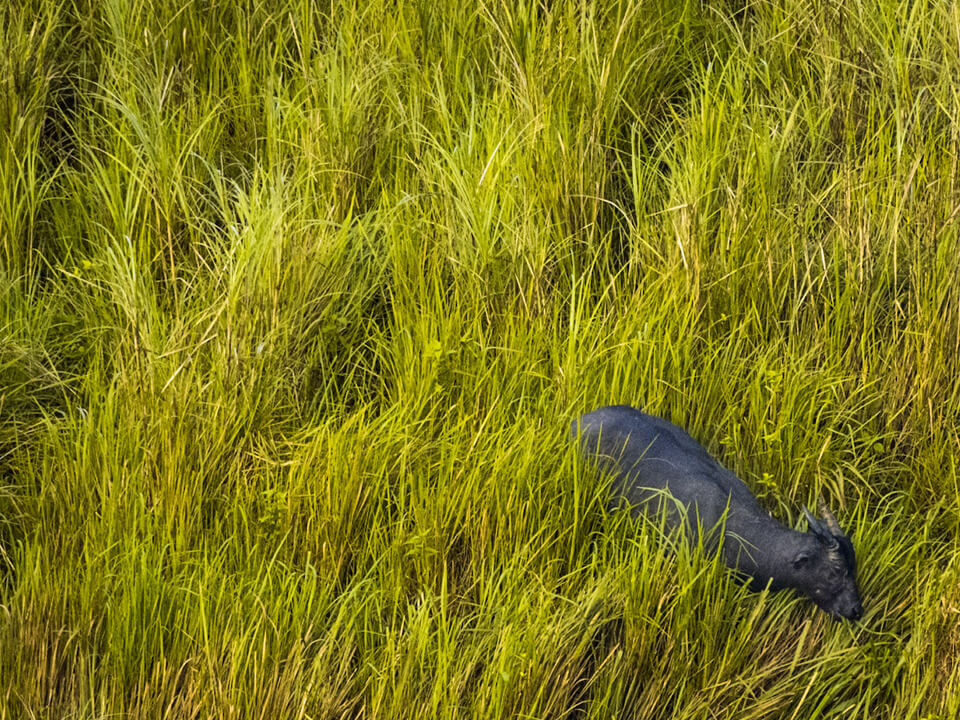By preserving biodiversity and ecosystems, we are retaining the ability of the planet to sustain our prosperity
ON THE BRINK OF EXTINCTION
The slopes of Mts. Iglit-Baco Natural Park (MIBNP) serve as the tamaraws’ natural habitat. Tamaraws are found only in the island of Mindoro located in the central-west of the Philippines. Although commonly mistaken as a common water buffalo, its smaller stature, shorter tail and straight, v-shape horns distinguish it from the other buffalo species. Tamaraws are classified as a critically endangered species under IUCN Red List of Threatened Species.
In the early 1900s, its population was estimated at around 10,000. By the 1950s, the species was on the brink, dropping to around 200-250 due to a rinderpest outbreak of the 1930s. While latest counts show an increasing trend, the population of tamaraws are still significantly low at 523 head in early 2018.
“I was packing when my 6-year old daughter suddenly came and asked me. “Where are you going?” I said, I’m going to the mountains to see the Tamaraws. “What is a Tamaraw? What does it look like?” I couldn’t explain more because I haven’t seen one either. I just told her that when I get back, I’ll show her tons of photos of the Tamaraws, what they look like in real life, and how they live in their own natural habitat.
I’d like to tell my kid a story about the tamaraws, that somewhat she’d think it’s from a fairy tale book, and something she will remember when she grows up. I’d like her to know the importance of the tamaraws in our society, how they are now considered as critically- endangered animals due to loss of habitat, and more importantly, how they are being preserved by the people working towards conservation and beyond.”-
Mitch De Juan, mountaineer and social media influencer, BioCamper
GUARDIANS OF THE TAMARAWS
“Habitat loss, hunting and poaching are the main threats to the tamaraws, ” according to Department of Environment and Natural Resources’ (DENR) Tamaraw Conservation Program (TCP) Coordinator, Maria Teresita “June” Pineda, Jr.-David.
Since its genesis in 1979, the Tamaraw Conservation Program (TCP) has been actively working to conserve and protect the tamaraws and their habitat. Ensuring the safety of the tamaraws means that rangers under the TCP must guard their posts in the national park and be away from their families for about a month, at a time. Receiving threats and dodging bullets from hunters are all part of the job.
Despite having limited resources and dysfunctional patrolling equipment to guard the 2,500-hectare strict protection zone, TCP’s dedicated team along only 26 tamaraw rangers work hard to keep the tamaraws safe from hunters and poachers. Even without stable employment, rangers wholeheartedly perform their jobs without any health and security benefits.
While the population of tamaraws is increasing – attributed to TCP’s efforts, the rangers along with the whole TCP team have yet to receive the funding and working conditions that they need and deserve.
An elderly Taw-buid passes by the BioCampers and proudly poses for the camera (Photo by Nella Lomotan)
Gab Visenio of Thirt Five Studios his fellow BioCampers while biking to Station 2 (Photo by Kim Lim, Sunny16 Lab)
IMPROVING CONSERVATION STATUS OF THREATENED AND ENDEMIC SPECIES
The Philippines’ target for wildlife conservation is “By 2028, the conservation status of nationally and globally threatened species in the country from 2016 levels is maintained or improved.”
Philippines is a biodiversity powerhouse, containing some of the world’s most unique and varied species in the world. Target 1 of the Philippine Biodiversity Strategy and Action Plan (PBSAP) – the country’s roadmap to conserving its biodiversity – seeks to maintain or improve the conservation status of nationally and globally threatened species in the country.
To date, other endemic animals and plants in the country are experiencing the same fate as that of the tamaraws and threatened with extinction. These include the Philippine Eagle, Negros Bleeding-Heart, Visayan Warty Pig, Dinagat Bushy-Tailed Cloud Rat , Philippine Tarsier , and many more.
REDUCING THREATS, ADDRESSING DRIVERS OF BIODIVERSITY LOSS











Comment (0)